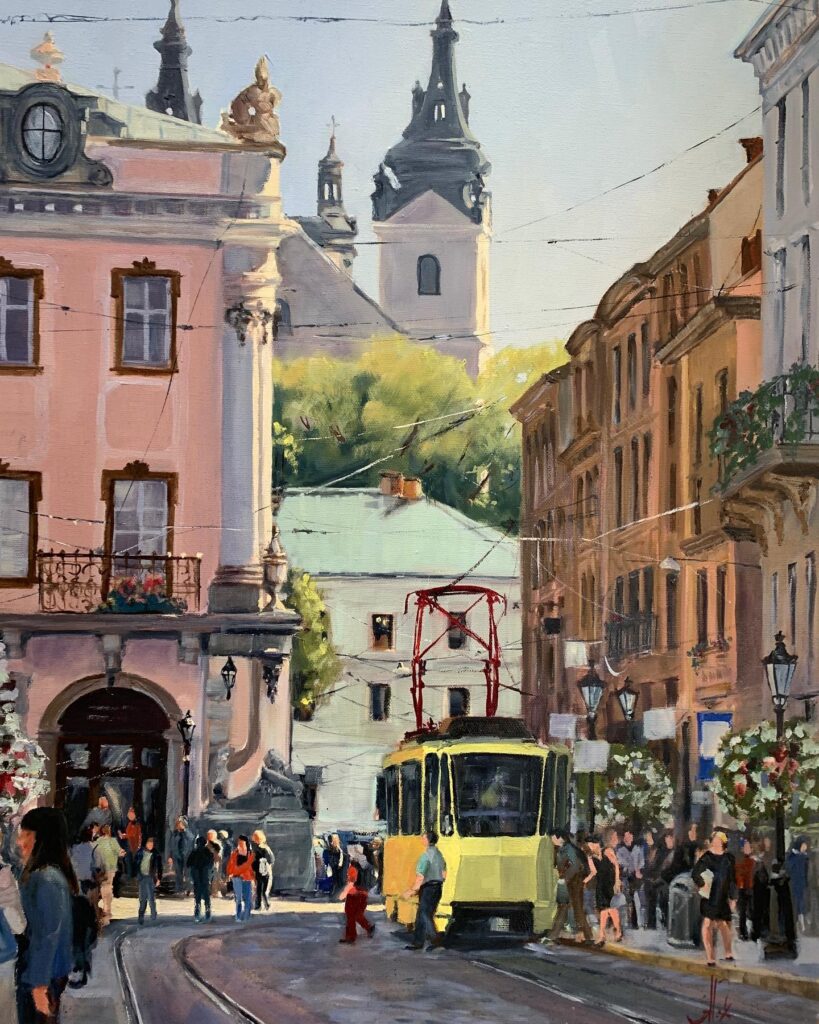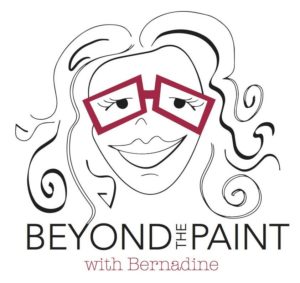Painter Alex Bigatti crosses the boundaries between realism and abstraction in her gestural or action paintings. Dive in with me in her boundless joy expressed through vivid colors and broken brushwork. You will also hear from the artist herself, including her insights into the symbolic meanings she explores from her subject onto the canvas.



Resources for this podcast include Alex Bigatti website, Alfa Art Gallery, writings of Stephen Little. Follow Alex on Instagram–she has two profiles. @alexbigatti_art and alexgestural.
Script: Welcome to Episode 108: Alex Bigatti: Between Realism and Abstraction
Painter Alex Bigatti crosses the boundaries between realism and abstraction in her gestural or action paintings. She sits with her canvas at specific locations, mostly in nature, like on a treed path or by a rumbling brook. In one sitting, moving the brush as she describes “very fast,” her innate energy combined with vibrant colors squeezed from tubes of paint, she observes, with her dancing eyes (more on Bigatti’s big personality in a moment) the interaction of light with color and shapes of her subject; shape and color are portrayed one against another.
I had the great privilege to visit Bigatti’s studio outside of New York, tucked in a sprawling suburb. An architect, she attended the University of Buenos Aires with a degree from its School of Architecture and Urban Planning, Bigatti designed the space, an extension on her home. The outside looks like the side of a barn, striped white and painted a deep red. Inside, steps from her dining room the space is flooded with light from ceiling to floor from windows that open into her deep back yard. The space has a high ceiling, beneath my feet, blonde wood floor. Everywhere is her art, her paintings, sculptures, a table of tubes of paint and a plethora of brushes. In the center is a working table. I made a short video of her space for my website and social media. It is warm and inviting like the artist–her big, open smile greeted me at the door. What is striking is her petite figure, neat and trim. It is striking because from that small vessel of her body is an outpouring of energy she thrusts onto the canvas. She speaks in equal measure with that same energy; her joy for her work is infectious.
The pandemic has hindered my opportunity to view works of art in person. Many of my episodes in the past year explore works of art from digital representations. I did view her work from her website before my visit. But in person, oh my, her paintings draw you in both quiet, contemplative ways and in other works, you feel like you are on the precipice of a wide mountain range, blazing in the sublime.
You will have the chance to hear from the artist in a conversation I recorded, but for now, journey with me in her series, “Gramineae,” inspired by Bluegrass and Folk music. Gramineae is “grasses” in Latin. Bigatti says the series “represent a simple form of life, ever growing, ever changing…A symbol of fullness of mind and body.” What does that look like–the fullness of mind and body? The series encompasses singular works, multiple views through a broad range of colors of grass–“lush, un-mowed.” In her studio, Bigatti had the series, approximately 20 works, arranged in and installed, like a grid, on one wall of her studio.
Each is a closeup view of blades of grass. Imagine you are lying on your belly in a meadow, head raised–from this viewpoint you see a mass of tall grass, arching and bending in different directions. The grasses are not observed and rendered with any precision. Individual blades are defined through gestural brushstrokes of varying widths. They are formed through juxtapositions of very vibrant colors; pink next to a yellow, dark blue fading into a light blue or deep red blurring into orange. There is a sense of motion, like the wind is rushing through, tossing the blades. In every work, we see, at the top of the canvas a swath of sky, not the familiar blue, the sky mirrors instead mirrors the colors of the palette of grasses, the tips of the blades gesticulate like waving arms in a crowd. Bigatti says the grasses represent abundance, new growth, health, happiness, and prosperity.”
Bigatti describes herself as a “constant learner, always in search of personal expression and the viewers’ emotional reactions from their observation.” Take a moment to sit with her words or the phrase, “in search of the viewers’ emotional reactions.” It describes the woman you will meet, her enthusiasm for painting as a way of connecting with others. I think that intention surfaces with the boldness we see in her works; that kind of deep engagement.
From early childhood, Bigatti loved drawing, painting and modeling with clay. She developed her own style of figurative and abstract painting using a variety of media from watercolors, acrylics, ink and oils. The Alfa Art Gallery who represented Bigatti in their review said, “her work is emphasized by vivid colors and brushstrokes. Her landscapes and still-lifes convey a sense of movement and liveliness that are enhanced by stylistic elements such as color scheme and brushstrokes. All of these factors create an original interpretation by the artist, which thus becomes an original journey for the viewer. ” I concur with the gallery’s interpretation. Bigatti does create an original journey for the viewer though her practice–through her fervent movements from brush to canvas.
In this episode you hear in my descriptions, gestural, action–Bigatti’s work and part of her style is rooted in the movement Abstract Expressionism. From the writer Stephen Little, “Abstract Expressionism developed in New York during the decades immediately following World War II. It is also referred to as the New York School or Action Painting. It is characterized by an attempt to depict universal emotions. Artists like Jackson Pollock subverted traditional methods of painting by throwing paint onto the canvas. There is a rhythmic vitality within the work. Opposite of Action paintings and variant within the Abstract Expressionism movement are Color Field paintings that also expressed universal symbols and emotions. Artists like Mark Rothko saturated the canvas with “luminous and brooding colors that evoke contemplative stillness. ” Women also focused on the expressive freedom of direct gesture and process that is at the core of abstract expressionism. Women like Elaine de Kooning, Lee Krasner, wife of Jackson Pollock, Grace Hartigan and Mary Abbott–her painting “All Green,” 1954, sweeps colorful greens and blues in her colorful canvas. The brushstrokes are thick and dense, the shapes reference nature.
Bigatti encapsulates in her abstract works a similar energy, the colors and broken brushwork vibe into her unique dance of physical energy.
There is also the embrace of realism that rides through her paintings; as noted earlier, they bridge between realism and the abstract. My favorite example is a small painting, “Curious Stream.” Bigatti shared, she painted “Curious Stream” at the Ross Farm, “a beautiful county-owned property in Basking Ridge, New Jersey. The farm has been opening its doors to the community for different arts-related events. The property has many features including a farmhouse, and other structures. The little stream running through it was very interesting to me.”
Let me describe it for you. From my view, I am immediately drawn into a blue stream rumbling through a lush landscape of trees and bright yellow and orange brush, perhaps bushes and leaves. there are recognizable trunks of trees anchored in the ground. The leaves and grasses and bushes are a mass of color, no defining leaves, just blotches of bursting colors, the orange collapses into the yellows and there is a mesh of greens. The water rhythmically babbles towards me, the viewer. There is a sense of quiet, like I am becoming one with the colors, the stream of water a lullaby.
Bigatti says, “I always love streams and rivers because they make me wonder where they come from and where they are going, their bends and turns and all the reflections they “steal “on their ways. I was moved by the energy of this little stream, the colors around it and the sound of the water and birds. I thought of it like a little curious being (hence the name) deciding where to go next and what it would find along its course, making you wonder where it turned at the point that you can’t see it anymore in the painting.”
Bigatti’s curious mind, the way she sees the world, her small corner in it, is so enchanting to me. In her painting “Morning Glow,” we experience a cityscape that is illustrates her skill in realism. Bigatti describes the work so eloquently: the provincial scene of partial views of buildings set on an open street with a yellow tram patiently waiting for passengers gingerly boarding. In the background a church steeple appears regal as it pierces a blue, blue sky. Bigatti describe it, “It is a painting depicting the glow of the morning light at the Rynok Square in Lviv Ukraine. I wanted to capture the subtle change in the temperature of the sky from the warm source of the sunlight to the cooler feel of the sky.”
Bigatti, as a female artist, does not push a feminist agenda in her prolific work. What she does in her artistic practice is respond to particular places, to her life experiences. It is her ability to experiment to abandon structure and traditions in her works it is where we truly see in the familiar, a fresh perspective, we experience the inner life of the artist–her infectious energy surfaces boldly moves through her paintings.
